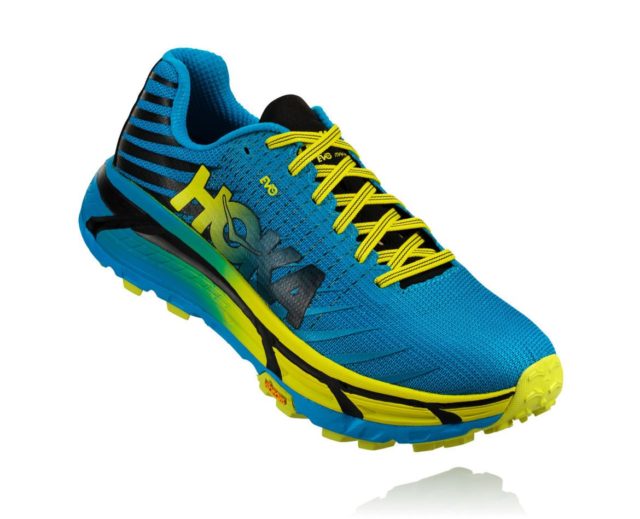
Hoka One One Evo Mafate
Stack Height: 33 mm (heel); 29 mm (toe)
Drop: 4 mm
Stated Features:
- High abrasion MATRYX (R) technology features Kevlar wires to optimize foot hold in strategic areas, and provides durability in any condition.
- Non-Wicking treated fabric optimizes water drainage
- Early stage Meta-Rocker optimizes heel-to-toe transitions
- R-BOUND™ midsole/outsole provides responsiveness and resistance to compression
- Vibram MegaGrip rubber outsole with aggressive 5mm lugs to face the most critical conditions.
MSRP: $170
Size Tested: 9.5
Blister’s Measured Weight (size 9.5):
- Shoes + Laces (no insoles): 281 g (left); 283 g (right)
- Insoles: 19 g (left); 19 g (right)
- Total Weight: 300 g (left); 302 g (right)
Test Locations: Mt. Shasta, CA; Portland, OR
Test Duration (so far): 70 miles
Reviewer: 5’10”, 155 lbs (my running background and preferences)
Intro
About eight years ago, Hoka One One released their first shoe, called the Mafate. It featured their now-famous combination of a giant midsole, rockered sole profile, and lightweight materials that really hadn’t been used in the running world before that point.
Fast forward eight years, and Hoka has released the newest iteration of their original shoe, the Evo Mafate. With a minimal, Kevlar-reinforced upper, a chunky midsole, and an aggressive but lightweight outsole, the Evo Mafate is Hoka’s race-oriented endurance running shoe. It’s also what many of their athletes have been using for 100+ mile races.
So where does this technical, purpose-built shoe fit into Hoka’s line? And should it be brought out only for the longest and gnarliest of runs, or can it work for mellower and / or shorter runs?
After around 70 miles in the Evo Mafate on all sorts of terrain, from roads to places where established trails aren’t even an option, I think I have a pretty good idea of where the Evo Mafate shines, and where other shoes might be more appropriate. I’ll also be comparing it to other Hoka trail shoes like the Torrent, (a less-cushioned trail shoe) and the Speedgoat 2 (one of Hoka’s other highly cushioned trail shoes).
Weight
The Evo Mafate is by no means light, but for the amount of cushioning, traction, and protection it offers, I think the weight is very reasonable. I never felt as if the Evo Mafate was a burden or too bulky while running in it. I was still able to maneuver and jump around on rocks, and do steep scrambles without any problems.
For reference, here are a few of our measured weights (per shoe, in grams) for some relevant shoes. As always, keep in mind the size differences to keep things apples-to-apples.
255 & 251 Hoka One One Torrent, size 9.5
297 & 297 Hoka One One Speedgoat 2, size 10
302 & 300 Hoka One One Evo Mafate size 9.5
335 & 337 Altra Timp, size 10
333 & 348 Altra Olympus 3.0, size 10
333 & 357 Hoka One One Stinson ATR 4, size 10
Fit
As always, we recommend trying on any shoe before buying it. But with that said, I’ll offer some fit notes here. For reference, I have pretty average-volume feet, but I have a wide midfoot and an average to low arch. In general, I tend to prefer wider shoes with roomy toe boxes.
The fit of the Evo Mafate took some getting used to. But once I got accustomed to the fit, I fell in love with these shoes. I typically prefer shoes with wider toe boxes where I’m able to wiggle my toes around a bit, but the Evo Mafate’s toe box feels far from roomy. But after a few runs I actually ended up appreciating this because it kept my foot locked down and gave me great in-shoe stability when running on uneven surfaces and hopping from rock to rock on technical trails. The upper of the Evo Mafate fits close to my foot around the toe box and is one of the defining aspects of the fit of this shoe (more on how that affects performance later).
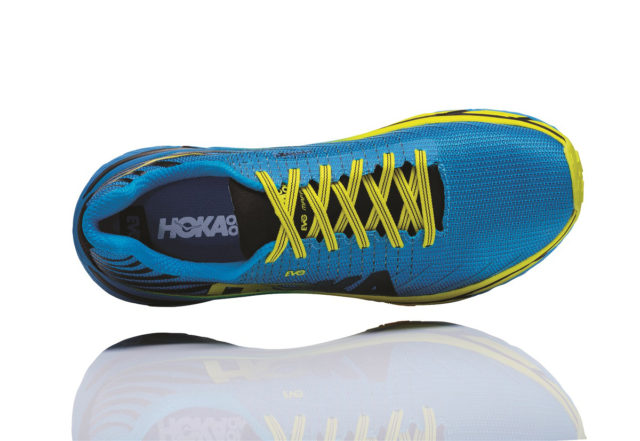
Through the midfoot area, the Evo Mafate fits close to my foot as well. This adds to the nice locked-down feeling, but some might be left wishing for a wider midfoot area. When I use shoes that have a narrower fit my feet often get sore, particularly on longer runs. I was happy to find that this was not the case with the Evo Mafate. The narrower midfoot wasn’t too tight, and provided the right balance between lockdown and comfort (for my feet). That said, I have pretty average-volume feet, so those with wider feet might not have the same experience.
With respect to the back of the shoe, my heel sits comfortably in the heel cup, and I’d say the Evo Mafate’s heel cup is similarly deep compared to the Speedgoat 2. The heel counter of the Evo Mafate is also taller than that of the Speedgoat 2, giving the Evo Mafate a fit that feels deeper than it actually is. The taller heel counter provides more Achilles protection and is reinforced which makes the heel feel protected. While tall heel counters can sometimes be uncomfortable, I haven’t had any problems with the height of the Evo Mafate’s heel counter.
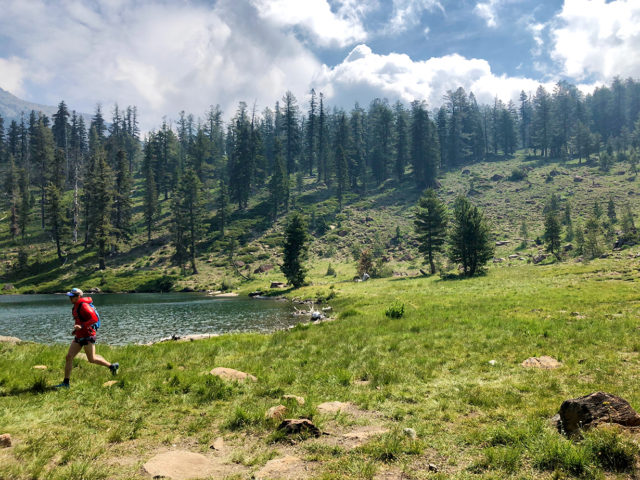
Compared to the Speedgoat 2, the Evo Mafate feels a bit higher-volume overall, though the difference isn’t extreme.
Overall, the Evo Mafate’s fit strikes a nice balance: it feels snug, but not in a way that is restrictive.
Upper
Before I dive in about my on-trail experience with the Evo Mafate’s upper, there are some key things that need to be said about it. First off, the upper of the Evo Mafate is made of MATRYX fabric, which is a kevlar and polyamide weave marketed to be extremely supportive, abrasion resistant, lightweight, and breathable. This material is pretty new to the running shoe market, and in my eyes is one of the defining features that makes the Evo Mafate so badass.
The Evo Mafate’s upper felt weird at first. I personally took at least three runs to really begin to enjoy it. It feels somewhat rigid out of the box, and as I mentioned earlier, it fits close to the foot. But the upper began to soften and conform to my foot once I started running, becoming increasingly more flexible and giving the shoe a glove-like fit. But unlike most shoes I’ve used, once the run is over, the Evo Mafate’s upper stiffens up slightly, which was very surprising. And yet, each time I run in the Evo Mafate, it takes less time for the upper to soften. So if you’re trying on the Evo Mafate and are concerned about the stiff upper, know that it will soften up a bit on each run.
The midfoot area of the upper integrates strong kevlar wires that run laterally from the eyelets to the midsole. These give the shoe some major lockdown, a feature that is important for running on irregular surfaces where your foot often ends up angled to the side (e.g., rocks, roots, or sides of hills).
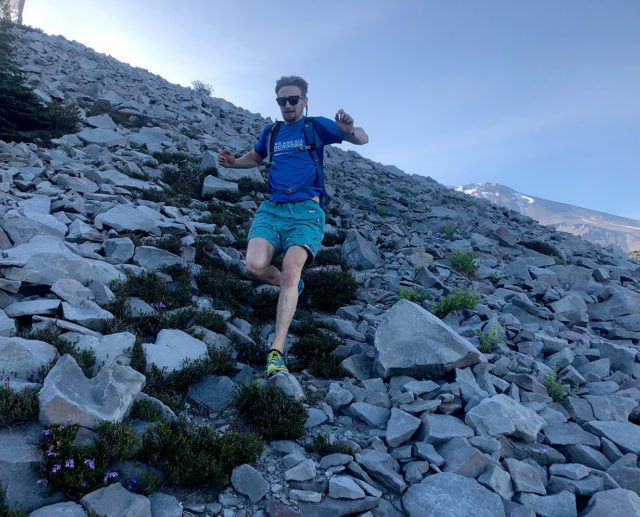
Compared to the Speedgoat 2 and Torrent, the upper on the Evo Mafate is extremely thin. And while its thin material made it seem like the Evo Mafate would offer less support, I found that its upper actually felt more supportive than the Torrent or the Speedgoat 2’s.
The Evo Mafate’s MATRYX upper offers a really good combination of support, durability, and low weight. The lockdown and fit of the Evo Mafate feels different than other shoes I’ve used, but after getting used to the unusual material I have fallen in love with the upper and its unique feel.
Midsole and Cushioning
The midsole on the Evo Mafate is exactly what I’d expect from Hoka’s top-of-the-line trail shoe: extremely cushioned and fat, but in a way that feels pretty dialed. The Evo Mafate’s midsole has a stack height of 29 mm in the forefoot and 33 mm in the heel, giving it a 4 mm drop. The midsole is also comprised of two different types of foam: a lightweight compressed EVA foam and a layer of Hoka’s “R-BOUND” material, which is integrated into the outsole of the shoe. (The R-BOUND material is the light blue material that surrounds the yellow outsole rubber).
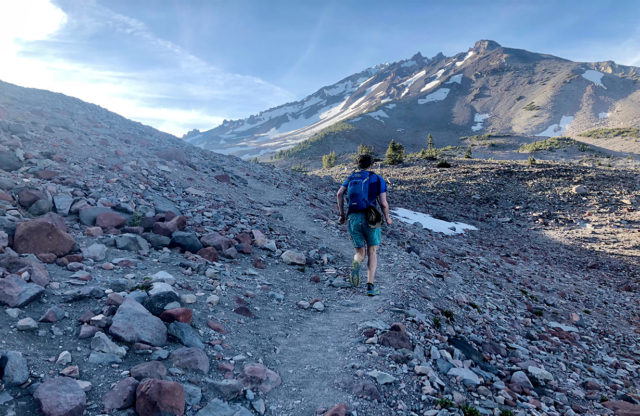
The R-BOUND material seems to add significant bounce to each stride, and the Evo Mafate provides noticeably more energy return than the Speedgoat 2 or the Torrent, which are both pretty springy shoes to begin with. The R-BOUND foam is thicker around the arch area of the shoe, which provides some pronation support. I appreciate this as I tend to overpronate a bit. Along with its added bounce, the R-BOUND portion of the outsole offers quality grip on many surfaces (see next section).
The Evo Mafate’s midsole is pretty stiff both laterally and longitudinally, which I personally enjoy. I find that the stiffer midsole gives the shoe a nice springy feel on takeoff and contributes to the energy return mentioned earlier. The midsole also features Hoka’s signature Meta-Rocker, which leads to a nice heel-to-toe transition on the ground. For those unfamiliar with Hoka’s rockered sole profiles, this basically means that the heel and toe areas are carved away / raised off the ground, which gives highly cushioned shoes like the Evo Mafate a more rounded profile and helps rock the foot forward in each stride. This makes for less vertical impact on each step, which I personally enjoy because it seems to decrease some stress on my joints.
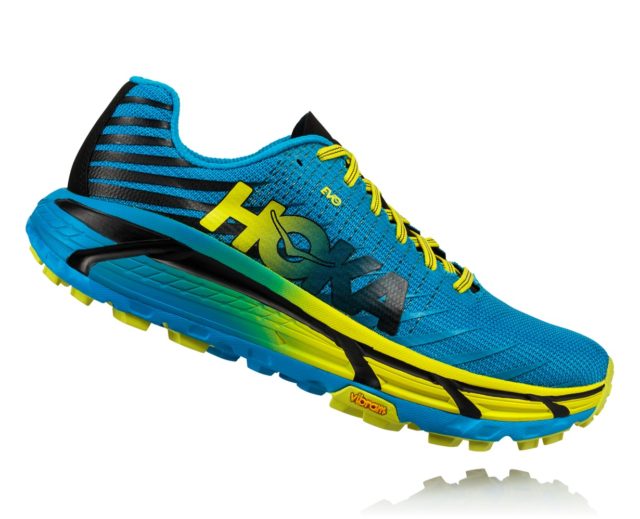
While the rockered sole and springy midsole help keep the Evo Mafate fairly efficient for its size, it’s still a pretty tall shoe, and one of my few gripes about this shoe is actually its height. I have found that when switching from the Torrent (stack height of ~20 mm) to the Evo Mafate, I tend to trip over roots, and rocks, and sometimes I even trip simply because I am not used to picking up my feet as high. On my first five runs in the Evo Mafate, I fell pretty hard about five times. While this may have been due to my own clumsiness, I think the height of the midsole definitely played a part in the scrapes, bruises, and facefulls of dirt I received, and will definitely be something to get used to for people coming from shoes with lower stack heights.
Outsole and Traction
The outsole of the Evo Mafate features a combination of the R-BOUND foam and Vibram MegaGrip rubber. The Vibram rubber is molded into the foam, and features very aggressive 5 mm lugs. The R-BOUND portion of the midsole also features several multi-directional lugs around the midfoot and arch that are slightly shorter than the Vibram lugs. After running and hiking on a number of different surfaces in these shoes, I have been really pleased with the traction. The rubber is sticky on dry rocks as well as wet surfaces like mud and wet rocks, and also grips well on trails and roots.
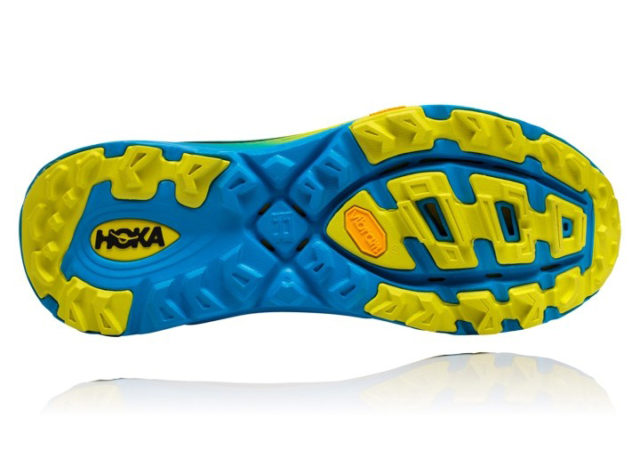
The Evo Mafate’s lug pattern is pretty aggressive compared to many trail shoes, but its mostly directional pattern and flex grooves help it feel fairly efficient on mellow trails. That said, the lugs are so large and sparsely spaced that they feel like a bit of a nuisance for runs on the road and tamer trails (granted, Hoka is very clear that the Evo Mafate is a technical trail shoe).
The Evo Mafate seems to be most at home on mud, deep sand, and gravel, but it performs very well across a wide range of surfaces. It grips better than both the Torrent and Speedgoat 2 on surfaces like pine needles, dust, and large rocks. Across wet rocks and deeper mud, the Vibram lugs have provided secure footing and I’ve never had any slippage when crossing wetter areas (though I’ve only had about two runs in the Evo Mafate where I encountered water on the trail, as California has been pretty dry lately). But so far, I have been more than happy with the traction the Evo Mafate provided on every surface I’ve gotten it on.
Durability
I’ve run about 50 miles in the Evo Mafate, and hiked 20 in it, so while I can’t yet judge its long-term durability, I have noticed a few things that are worth noting.
The upper is in extremely good condition — the Kevlar weave seems to be doing its job of maintaining the shoe’s structure and it seems to continually break-in more on each run. There are some dirt stains that are nearly impossible to clean off because the weave is pretty tight, but that’s not a big deal in my mind.
The collar on the instep side of each shoe is wearing, which is likely due to my gait. The left collar has worn through to the padding, which seems like it could potentially become a problem, but so far I haven’t noticed it while running.
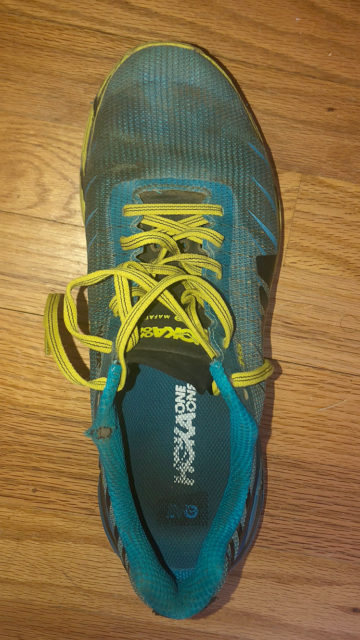
The Evo Mafate’s outsole has held up pretty well overall. There are some minor chunks missing from the foam lugs near the midfoot, as well as some minor delamination of the main toe-lug on the left shoe, but these are again not noticeable when running.
The wear on the Evo Mafate is very similar to the wear that I have noticed on other pairs of Hokas I’ve used, but those shoes did not deteriorate much after the initial things like scuffing of the midsole, normal wear of the outsole, etc. I’ll post an update when I get more miles in the Evo Mafate, and will then weigh in on the long-term durability of these shoes.
Who’s It For?
Hoka markets the Evo Mafate as their top-of-the-line trail shoe for long runs, and it’s the shoe that Jim Walmsley used when he broke the course record for the Western States 100-miler with a time of 14.5 hours. While I think it is definitely a good option for serious runs like that, I also think it’s a good option for anyone who is looking to put lots of miles on technical trails, even if you’re not into racing.
The Evo Mafate sets itself apart from many other shoes thanks to its thin-but-supportive MATRYX upper, unique cushioning, and quality energy return. So if you are looking to run some hard miles in the mountains and like to beat up your shoes but not your feet and joints, check out the Evo Mafate.
If you prioritize ground feel or stability over cushioning, the Evo Mafate is probably not the best shoe for you. It has a lot of cushioning and a high stack height, meaning that at times it can be a bit easy to roll your ankle. That said, as someone who’s run many miles in shoes with higher stack heights, I have yet to experience problems with the Evo Mafate’s stability. And given how thick its midsole is, the Evo Mafate doesn’t completely mute out everything on the trail. That being said, those who prioritize ground feel and stability for off-camber terrain may want to direct their attention to less-cushioned shoes like the Hoka Torrent.
Ultimately, I think the Evo Mafate is best for someone who is looking to run (or hike) long miles on the trails.
Bottom Line
I think the Hoka Evo Mafate is an excellent trail shoe for long runs, and its integration of multiple different technologies makes it an extremely fun shoe to run in. It provides Hoka’s hallmark cushioning without the lazy / inefficient energy return that other max-cushioned shoes can suffer from. The MATRYX upper provides a really good blend of low weight, protection, support, breathability, and durability. And when that upper is combined with the Evo Mafate’s average- to low-volume fit, it makes for a surprisingly secure feel. Whether you’re racing or not, if you want a highly cushioned trail shoe for a variety of terrain, the Evo Mafate is definitely worth a look.

I guess reason for alling are the lugs. Either they give way, or they get caught, and you fall. So, I am happy with my Bondi 5’s, as long as there is no wet clay or snow involved, there is no reason to have lugs on a maximalist shoe. That being said by a desert dweller.